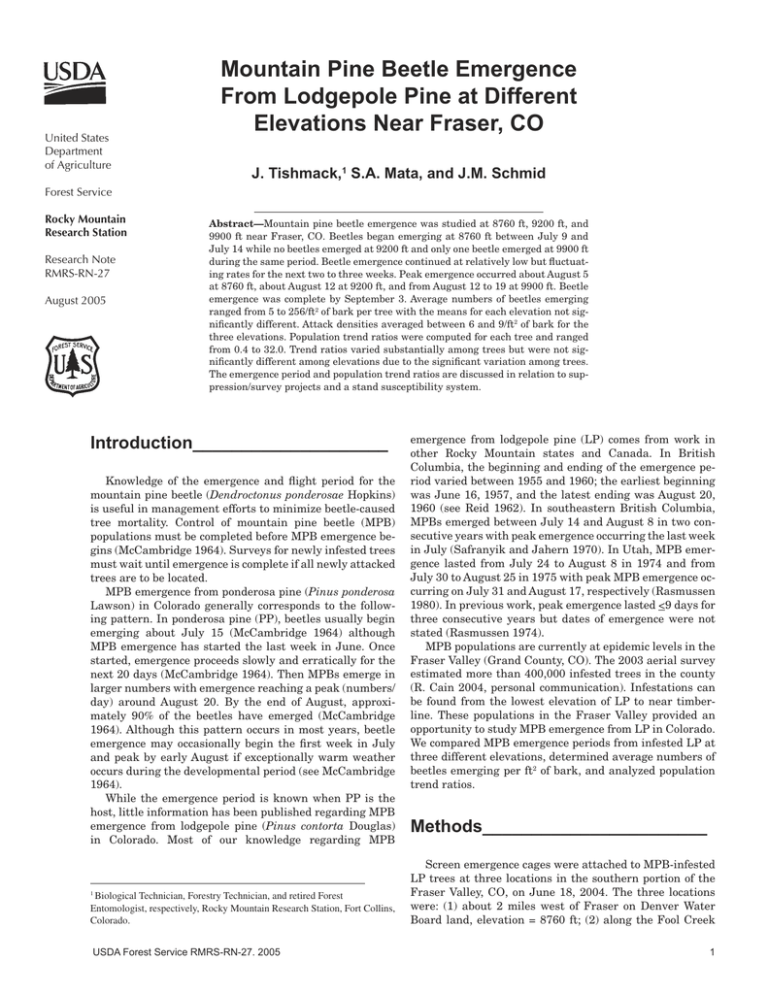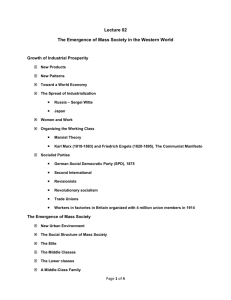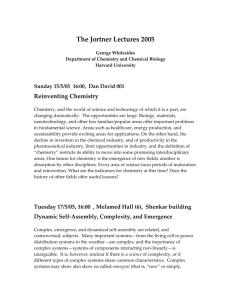Mountain Pine Beetle Emergence From Lodgepole Pine at Different J. Tishmack,
advertisement

United States Department of Agriculture Mountain Pine Beetle Emergence From Lodgepole Pine at Different Elevations Near Fraser, CO J. Tishmack,1 S.A. Mata, and J.M. Schmid Forest Service Rocky Mountain Research Station Research Note RMRS-RN-27 August 2005 Abstract—Mountain pine beetle emergence was studied at 8760 ft, 9200 ft, and 9900 ft near Fraser, CO. Beetles began emerging at 8760 ft between July 9 and July 14 while no beetles emerged at 9200 ft and only one beetle emerged at 9900 ft during the same period. Beetle emergence continued at relatively low but fluctuating rates for the next two to three weeks. Peak emergence occurred about August 5 at 8760 ft, about August 12 at 9200 ft, and from August 12 to 19 at 9900 ft. Beetle emergence was complete by September 3. Average numbers of beetles emerging ranged from 5 to 256/ft2 of bark per tree with the means for each elevation not significantly different. Attack densities averaged between 6 and 9/ft2 of bark for the three elevations. Population trend ratios were computed for each tree and ranged from 0.4 to 32.0. Trend ratios varied substantially among trees but were not significantly different among elevations due to the significant variation among trees. The emergence period and population trend ratios are discussed in relation to suppression/survey projects and a stand susceptibility system. Introduction____________________ Knowledge of the emergence and flight period for the mountain pine beetle (Dendroctonus ponderosae Hopkins) is useful in management efforts to minimize beetle-caused tree mortality. Control of mountain pine beetle (MPB) populations must be completed before MPB emergence begins (McCambridge 1964). Surveys for newly infested trees must wait until emergence is complete if all newly attacked trees are to be located. MPB emergence from ponderosa pine (Pinus ponderosa Lawson) in Colorado generally corresponds to the following pattern. In ponderosa pine (PP), beetles usually begin emerging about July 15 (McCambridge 1964) although MPB emergence has started the last week in June. Once started, emergence proceeds slowly and erratically for the next 20 days (McCambridge 1964). Then MPBs emerge in larger numbers with emergence reaching a peak (numbers/ day) around August 20. By the end of August, approximately 90% of the beetles have emerged (McCambridge 1964). Although this pattern occurs in most years, beetle emergence may occasionally begin the first week in July and peak by early August if exceptionally warm weather occurs during the developmental period (see McCambridge 1964). While the emergence period is known when PP is the host, little information has been published regarding MPB emergence from lodgepole pine (Pinus contorta Douglas) in Colorado. Most of our knowledge regarding MPB Biological Technician, Forestry Technician, and retired Forest Entomologist, respectively, Rocky Mountain Research Station, Fort Collins, Colorado. 1 USDA Forest Service RMRS-RN-27. 2005 emergence from lodgepole pine (LP) comes from work in other Rocky Mountain states and Canada. In British Columbia, the beginning and ending of the emergence period varied between 1955 and 1960; the earliest beginning was June 16, 1957, and the latest ending was August 20, 1960 (see Reid 1962). In southeastern British Columbia, MPBs emerged between July 14 and August 8 in two consecutive years with peak emergence occurring the last week in July (Safranyik and Jahern 1970). In Utah, MPB emergence lasted from July 24 to August 8 in 1974 and from July 30 to August 25 in 1975 with peak MPB emergence occurring on July 31 and August 17, respectively (Rasmussen 1980). In previous work, peak emergence lasted <9 days for three consecutive years but dates of emergence were not stated (Rasmussen 1974). MPB populations are currently at epidemic levels in the Fraser Valley (Grand County, CO). The 2003 aerial survey estimated more than 400,000 infested trees in the county (R. Cain 2004, personal communication). Infestations can be found from the lowest elevation of LP to near timberline. These populations in the Fraser Valley provided an opportunity to study MPB emergence from LP in Colorado. We compared MPB emergence periods from infested LP at three different elevations, determined average numbers of beetles emerging per ft2 of bark, and analyzed population trend ratios. Methods_______________________ Screen emergence cages were attached to MPB-infested LP trees at three locations in the southern portion of the Fraser Valley, CO, on June 18, 2004. The three locations were: (1) about 2 miles west of Fraser on Denver Water Board land, elevation = 8760 ft; (2) along the Fool Creek 1 road on the Fraser Experimental Forest about 5 miles southwest of Fraser, elevation = 9200 ft; and (3) further south up Fool Creek road on the Fraser Experimental Forest, elevation = 9900 ft. One cage was attached on the north side at breast height to each of eight trees at 8760 ft, each of six trees at 9200 ft, and each of six trees at 9900 ft elevation. Each cage covered about 2 ft2 of bark surface. The north sides were caged because greater densities are usually found on that aspect in LP (see Reid 1963) and in PP (McCambridge 1964, Negron and others 2001). Cages were first checked on June 24, 2004, then weekly beginning on July 9 until September 3, 2004. Numbers of MPBs captured in jars attached to the cages were counted and recorded for each collection date. To derive the relationship between MPB emergence and calendar date, the number of MPBs collected from all trees at each elevation were added together for each collection date. The total number for each elevation on a specific date was then divided by the number of days since the previous collection date. The quotient represented the average number emerging each day since the previous collection date. The quotients were plotted on the specific collection dates to derive a generalized trend for MPB emergence. The specific date for peak emergence at each elevation could not be determined because cages were not checked daily. However, the time period when peak emergence probably occurred was determined and we refer to the periods as “peak emergence.” When MPBs were no longer found in the jars and emergence was considered finished, the cages were removed. Within the area covered by each cage, one 6” X 12” bark sample (0.5 ft2 of bark) was removed. The number of attacks within the sample were counted and recorded. That number was multiplied by 2 to derive the number of attacks per ft2. Assuming two beetles (1 male and 1 female) create the gallery and brood arising from each attack, the number of attacks per ft2 was then multiplied by 2 to derive the number of MPBs creating the attacks in that ft2 of bark. A population trend ratio (PTR) was determined for each tree at each elevation by dividing the number of MPBs emerging per ft2 by the number of MPBs creating the attack densities per ft2. The number of MPBs emerging per ft2 of bark equalled the total number of MPBs emerging in each cage during the emergence period divided by 2. The number of MPBs creating the attack densities was derived as described in the previous paragraph. The PTR is the quotient of the number of MPBs emerging per ft2 divided by the number of MPBs creating the attack densities. A PTR >1 indicates an increasing population while a PTR <1 indicates a decreasing population. A multiresponse permutation procedure (MRPP, Mielke and Berry 2001) was used to compare emergence profiles among elevations. MRPP was also used to compare the total number of beetles emerging per ft2, attack densities/ft2, and PTR among elevations. Results and Discussion__________ Emergence No beetles emerged before July 9 at any of the three elevations. Between July 9 and July 14, beetles emerged 2 from five of the eight trees at 8760 ft, no beetles emerged from trees at 9200 ft, and one beetle emerged from one tree at 9900 ft (table 1). From July 14 to July 30, the number of emerging beetles increased at each elevation with average numbers per tree much greater from trees at 8760 ft than at either of the higher elevations. The number of beetles emerging between July 30 and August 5 increased at least five times the number emerging between July 23 and July 30 at each elevation (table 1). Between August 5 and August 12, the number of emerging beetles declined at 8760 ft but increased at the higher elevations. Between August 12 and August 19, the number of emerging beetles continued to decline at 8760 ft, declined at 9200 ft, and was about equal to the number emerging during the previous week at 9900 ft. By August 26, MPB emergence at 8760 ft declined to 11 beetles during the previous seven days while emergence at 9200 ft and 9900 ft also declined but was greater than at 8760 ft. During the period of August 26 to September 2, emergence was essentially complete at 8760 ft and declined slightly at 9200 and 9900 ft in comparison to the previous collection period. On September 3, only one beetle was found at 9200 ft and no beetles at the other two elevations, so MPB emergence was considered complete (table 1). As depicted by the average number of MPBs emerging per day (figure 1), the emergence profiles differed between 8760 ft and the other two higher elevations (p <0.05). Emergence at the lowest elevation began before emergence at the two higher elevations. Peak MPB emergence at 8760 ft began one week before peak emergence at 9200 and 9900 ft. Peak emergence lasted about one week at 8760 ft and 9200 ft but appeared to last about two weeks at 9900 ft. Peak emergence over a one week period generally agrees with the duration of peak emergence for MPB in LP in Utah (see Rasmussen 1974). Although MPBs were still emerging at 8760 ft during the August 26-September 2 collection period, their numbers were relatively low compared to the numbers emerging at the other two elevations. Thus, emergence at 8760 ft may have ended about one week before it terminated at 9200 and 9900 ft. The general pattern of MPB emergence from LP followed the emergence patterns for MPB in PP as determined by McCambridge (1964) and Schmid (1972). Once emergence began, MPBs emerged at relatively low variable rates for two to three weeks. Peak emergence generally occurs over a one to two week period after which emergence ceases by the end of August or early September. In the central Rockies, the initiation of MPB emergence from LP appears to coincide with the dates at which MPB emergence commences in PP (see McCambridge [1964] and Schmid [1972]). However, the termination of MPB emergence in LP, at least for 2004, varied with respect to the termination of emergence in PP, terminating sooner in LP than in PP in Colorado (see McCambridge 1964) and in the southern Black Hills (J.M. Schmid, unpublished data) but coinciding with the termination of emergence in PP in the Black Hills in 1966 and 1967 (see Schmid 1972). For 2004, peak MPB emergence from LP at 9200 ft and 9900 ft coincided with the peak emergence period of midAugust observed by McCambridge (1964) in PP in Colorado while peak emergence from 8760 ft was more similar to a mid-August date reported by McCambridge (1967). Considering the reports by Reid (1962), Rasmussen (1980), USDA Forest Service RMRS-RN-27. 2005 Table 1—Numbers of emerging MPBs per tree by collection date and location. “No” in the table means that the jars were not checked on those trees on that date. Collection date July 14 July 15 July 20 July 23 July 30 Aug 5 Aug 12 Aug 19 0 0 0 0 0 0 0 0 4 37 9 4 4 No No No 0 12 0 0 0 0 4 6 7 84 8 9 9 9 6 46 12 31 10 0 0 0 7 22 17 60 26 5 7 11 46 72 35 15 246 380 136 253 87 32 2 18 52 100 60 99 21 2 4 4 5 11 9 7 1 3 0 1 0 2 0 7 0 1 0 2 0 1 1 2 1 0 0 0 0 0 0 0 0 0 0 0 0 0 0 0 0 0 0 0 0 0 2 0 2 0 1 1 0 3 1 0 0 1 0 1 1 1 1 2 4 2 3 2 10 7 13 35 57 3 17 54 62 183 279 30 22 48 67 92 64 49 5 42 6 3 9 15 3 6 8 2 10 12 2 4 0 0 0 1 0 0 0 0 0 0 0 0 0 0 0 1 0 0 0 0 0 0 0 1 0 0 0 2 0 0 1 1 1 0 0 0 2 0 0 1 0 0 11 16 5 4 1 3 119 166 40 20 38 2 204 44 28 7 104 2 37 3 10 0 17 0 19 9 5 1 20 2 0 0 0 0 0 0 Average number of MPB Emerging per day per collection period Elevation 8760 ft. Tree 1 Tree 2 Tree 3 Tree 4 Tree 5 Tree 6 Tree 7 Tree 8 Elevation 9200 ft. Tree 1 Tree 2 Tree 3 Tree 4 Tree 5 Tree 6 Elevation 9900 ft. Tree 1 Tree 2 Tree 3 Tree 4 Tree 5 Tree 6 July 9 and McCambridge (1964 and 1967), the MPB emergence period and date of peak emergence varies considerably from year to year. Densities of Emerging Beetles The number of MPBs emerging per ft2 of bark varied among trees and elevations (Table 2). The number of MPBs emerging per ft2 of bark ranged from 40 to 256 at 8760 ft, 30 to 213 at 9200 ft, and 5 to 196 at 9900 ft (table 2). The number of MPBs emerging from trees at 8760 ft was not significantly greater than the number emerging at 9200 and 9900 ft (p = 0.47). USDA Forest Service RMRS-RN-27. 2005 Aug 26 Sept 2 Sept 3 Figure 1—Average number of mountain pine beetles emerging per day for three elevations for each collection date. In comparison to MPB densities emerging per ft2 of LP from other locations, 75% of the trees in this study had densities generally within the range observed by Reid (1963) for LP in British Columbia but 25 percent of the 20 caged trees had densities exceeding the largest number recorded in Reid’s study. Attack Densities MPB attack densities ranged from 2 to 14/ft2 for the three elevations. More specifically, attack densities ranged from 4 to 8/ft2 at 8760 ft, 6 to 14/ft2 at 9200 ft, and 2 to 8/ft2 at 9900 ft (table 2). The bark sample from the tree with only 3 Table 2—Number of emerging MPBs per ft2, attack densities per ft2, and population trend ratios per tree by location. Number of MPBs/ft2 Elevation 8760 ft. Tree 1 Tree 2 Tree 3 Tree 4 Tree 5 Tree 6 Tree 7 Tree 8 Average Elevation 9200 ft. Tree 1 Tree 2 Tree 3 Tree 4 Tree 5 Tree 6 Average Elevation 9900 ft. Tree 1 Tree 2 Tree 3 Tree 4 Tree 5 Tree 6 Average Attack densities/ ft2 40 132 178 256 113 194 86 92 136 8 8 8 4 8 6 4 8 6.8 2.5 8.2 11.1 32.0 7.1 16.2 10.8 5.8 11.7 81 160 213 56 30 83 104 8 6 10 6 14 8 8.7 5.1 13.3 10.6 4.7 1.1 5.2 6.7 196 120 44 18 90 5 79 8 6 8 8 2 6 6.3 12.3 10.0 2.8 1.1 22.5 0.4 8.2 two attacks/ft2 had about 1/3 of the sample devoid of MPB galleries. Generally, attack densities averaged between 6 and 9/ft2 and were not significantly different among elevations (p = 0.55). MPB attack densities of this magnitude were comparable to attack densities for MPB infestations in LP in British Columbia where Reid (1963) found densities averaging from 5.1 to 10.9/ft2 of bark but ranging from 0 to 21. Densities were slightly less than the 9.6 and 10.4 attacks/ ft2 found by Rasmussen (1980) in Utah in 1974 and 1975. In comparison to attack densities in PP, attack densities in this study were slightly greater than average attack densities found by McCambridge (1967). Population Trend Ratio (PTR) The PTRs varied substantially among trees but were not distinguishable among elevations (p = 0.57). PTRs ranged from 2.5 to 32.0 for trees at 8760 ft, from 1.1 to 13.3 for trees at 9200 ft, and from 0.4 to 22.5 for trees at 9900 ft (table 2). If the PTRs for the caged areas are indicative of MPB emergence for entire trees and trees attacked in 2004 have DBHs and attack densities equal to those observed for MPB-attacked trees in 2003, then forest managers expected a substantial increase in the number of MPB-attacked trees in 2004 as compared to 2003 unless mortality during the flight period was greater than that of previous years. At 8760 ft, the number of MPB-attacked trees would be more than 11 times the number attacked in 2003. Similarly, the number of MPB-attacked trees at 9200 ft in 2004 would 4 PTR be more than six times the number attacked in 2003 and the number at 9900 ft would be more than eight times the 2003 number. Management Implications_________ The MPB emergence pattern in LP suggests that control/ suppression projects should be completed or terminated by the first week in July. Such efforts could be continued past the first week in July but control efficiency would decline with each passing day. July 15 should be the cutoff date if projects are extended past July 1. The emergence patterns also suggest that surveys for locating newly attacked trees could begin the first week in September. Surveys conducted in mid-September would expect to locate all of the newly attacked trees and estimates would not be in error because of trees attacked after the survey had begun. In the stand susceptibility rating method of Amman and others(1977), the 9500 ft elevation is the threshold separating highly susceptible stands from moderately susceptibile stands. This threshold was established because as elevation increases, beetle development is retarded which increases beetle mortality and thus reduces the MPB population (Amman and others 1977). Based on the PTRs for the caged trees at 9900 ft, MPB populations increased substantially in 2004 (table 2), which suggests that winter temperatures may have been less influential during the preceeding year. USDA Forest Service RMRS-RN-27. 2005 For the MPB in LP, cold hardiness—the ability to survive lethal winter temperatures—begins to develop in the fall, reaches a maximum in December, January, and February, and begins to decline in late February or early March (Wygant 1938). During December thru February when maximum cold hardiness is achieved, larval mortality begins at temperatures ≤ -20oF but only about 10 percent of the population dies (Wygant 1938). Larval mortality increases to 25 percent at -25oF (Wygant 1938). From October 2003 to April 2004, the lowest winter temperature at the Fraser Experimental Forest headquarters at 9000 ft was -24oF on February 12, 2004, and all other minimum temperatures were higher than -20oF.2 This suggests that winter minimum monthly temperature(s) may not have caused extensive larval mortality. Further, the average minimum monthly temperatures from November 2003 through March 2004 at the headquarters compound were generally warmer than the long-term minimum averages for four of the five months2. Average minimum monthly temperatures (86 percent for November 2003, 79 percent for December 2003, 61 percent for January 2004, and 98 percent for March 2004) were warmer than the long-term averages2. Only in February 2004 was the average minimum monthly temperature colder than the long-term average minimum temperature2. During that month, the average minimum temperature was colder about 64 percent of the time. If winters are relatively milder, temperature presumably would have less influence on MPB mortality and more beetles would survive. In years of relatively mild winter weather when minimum temperatures rarely drop below -25oF, the 9500 ft threshold may have to be modified for Colorado, i.e., the upper elevational limit for highly susceptible stands in the Amman and others (1977) rating method should be raised to ≥10,000 ft. References_____________________ Amman, G.D.; McGregor, M.D.; Cahill, D.B.; Klein, W.H. 1977. Guidelines for reducing losses of lodgepole pine to the mountain pine beetle in unmanaged stands in the Rocky Mountains. Gen. Tech. Rep. INT-36. Ogden, UT: U.S. Department of Agriculture, Forest Service, Intermountain Forest and Range Experiment Station. 19 p. McCambridge, W.F. 1964. Emergence period of Black Hills beetles from ponderosa pine in the central Rocky Mountains. Res. Note RM-32. Fort Collins, CO: U.S. Department of Ariculture, Forest Service, Rocky Mountain Forest and Range Experiment Station. 4 p. McCambridge, W.F. 1967. Nature of induced attacks by the Black Hills beetle, Dendroctonus ponderosae (Coleoptera: Scolytidae). Annals Entomological Society of America. 60: 920-928. Negron, J.F.; Shepperd, W.D.; Mata, S.A.; Popp, J.B.; Asherin, L.A.; Schoettle, A.W.; Schmid, J.M.; Leatherman, D.A. 2001. Solar treatment for reducing survival of mountain pine beetle in infested ponderosa and lodgepole pine logs. Res. Pap. RMRSRP-30. Fort Collins, CO: U.S. Department of Ariculture, Forest Service, Rocky Mountain Research Station. 11 p. Mielke, P.W. Jr.; Berry, K.J. 2001. Permutation methods—A distance function approach. Springer. 352 p. Rasmussen, L. A. 1974. Flight and attack behavior of mountain pine beetles in lodgepole pine of northern Utah and southern Idaho. Res. Note INT-180. Ogden, UT: U.S. Department of Agriculture, Forest Service, Intermountain Forest and Range Experiment Station. 7 p. Rasmussen, L.A. 1980. Emergence and attack behavior of the mountain pine beetle in lodgepole pine. Res. Note INT-297. Ogden, UT: U.S. Department of Agriculture, Forest Service, Intermountain Forest and Range Experiment Station. 7 p. Reid, R.W. 1962. Biology of the mountain pine beetle, Dendroctonus monticolae Hopkins, in the east Kootenay Region of British Columbia. I. Life cycle, brood development, and flight periods. Canadian Entomologist 94: 531-538. Reid, R.W. 1963. Biology of the mountain pine beetle, Dendroctonus monticolae Hopkins, in the east Kootenay Region of British Columbia. III. Interaction between the beetle and its host, with emphasis on brood mortality and survival. Canadian Entomologist 95: 225-238. Safranyik, L.; Jahern R. 1970. Emergence patterns of the mountain pine beetle from lodgepole pine. Canadian Department of Fisheries and Forests Bimonthly Res. Notes 26:11, 19 Schmid, J.M. 1972. Emergence, attack densities, and seasonal trends of mountain pine beetle (Dendroctonus ponderosae) in the Black Hills. Res. Note RM-211. Fort Collins, CO: U.S. Department of Ariculture, Forest Service, Rocky Mountain Research Station. 7 p. Wygant, N.D. 1938. Critical low temperatures for the Black Hills beetle 1937-1938. Unpublished data on file at the Rocky Mountain Research Station, Fort Collins, Colorado. 27 p. L.Porth, statistician at the Rocky Mountain Research Station, US Forest Service, Fort Collins, CO, provided the temperature information as derived from the long-term temperature records taken at the Fraser Experimental Forest headquarters. 2 USDA Forest Service RMRS-RN-27. 2005 5 You may order additional copies of this publication by sending your mailing information in label form through one of the following media. Please specify the publication title and series number. Fort Collins Service Center Telephone FAX E-mail Web site Mailing address (970) 498-1392 (970) 498-1396 rschneider@fs.fed.us http://www.fs.fed.us/rm Publications Distribution Rocky Mountain Research Station 240 West Prospect Road Fort Collins, CO 80526 Rocky Mountain Research Station Natural Resources Research Center 2150 Centre Avenue, Building A Fort Collins, CO 80526 RMRS ROCKY MOUNTAIN RESEARCH STATION The Rocky Mountain Research Station develops scientific information and technology to improve management, protection, and use of the forests and rangelands. Research is designed to meet the needs of the National Forest managers, Federal and State agencies, public and private organizations, academic institutions, industry, and individuals. Studies accelerate solutions to problems involving ecosystems, range, forests, water, recreation, fire, resource inventory, land reclamation, community sustainability, forest engineering technology, multiple use economics, wildlife and fish habitat, and forest insects and diseases. Studies are conducted cooperatively, and applications may be found worldwide. Research Locations Flagstaff, Arizona Fort Collins, Colorado* Boise, Idaho Moscow, Idaho Bozeman, Montana Missoula, Montana Reno, Nevada Albuquerque, New Mexico Rapid City, South Dakota Logan, Utah Ogden, Utah Provo, Utah *Station Headquarters, Natural Resources Research Center, 2150 Centre Avenue, Building A, Fort Collins, CO 80526. The U.S. Department of Agriculture (USDA) prohibits discrimination in all its programs and activities on the basis of race, color, national origin, sex, religion, age, disability, political beliefs, sexual orientation, or marital or family status. (Not all prohibited bases apply to all programs.) Persons with disabilities who require alternative means for communication of program information (Braille, large print, audiotape, etc.) should contact USDA’s TARGET Center at (202) 720-2600 (voice and TDD). To file a complaint of discrimination, write USDA, Director, Office of Civil Rights, Room 326 W, Whitten Building, 1400 Independence Avenue, SW, Washington, D.C. 20250-9410 or call (202) 720-5964 (voice and TDD). USDA is an equal opportunity provider and employer. Federal Recycling Program Printed on Recycled Paper




